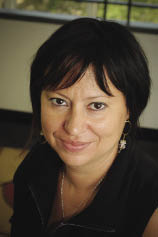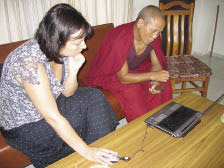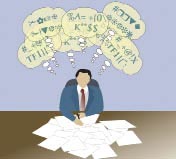Research
- Mind Over Matter
- New Vaccine Takes Aim at the Uncommon Cold
- Mason Receives $7 Million Contract to Counter IEDS
- As Economy Worsens So Do Attitudes about Workplace Diversity
- Novel Research Unshackles Traditional Operations behind Bars
Mind Over Matter
Researcher studies monks and meditation to learn more about concentration
and visual memory.
By Tara Laskowski, MFA ’05

Maria Kozhevnikov
Some people say they can remember something better if they see it written down—say, a phone number or a password. Although often, when visual memory is tested, one’s capacity for recalling details of a room’s layout, a person’s clothing, or a painting only goes so far. Eyewitness testimony in crimes, for example, becomes less accurate as time goes by.
But what of monks who have long been known for their ability to meditate and claim to be able to keep a very complex religious image in their minds for a long time? Are their techniques super memory machines? And if so, what can we learn from them?
Recently, Mason psychology professor Maria Kozhevnikov was tasked with learning the answers to some of these questions.
Through colleague and advisor Stephen Kosslyn, professor of psychology at Harvard, Kozhevnikov was involved in carrying out an intriguing experiment first commissioned by the Dalai Lama. At a cognitive neuroscience conference several years ago at MIT, the Dalai Lama said that accomplished monks who meditate on religious
images of a deity can keep a complex image in their mind for up to 24 hours. The Dalai Lama asked the researchers to look at accomplished monks. If the
thesis was true, it would change the way people think about visual imagery.
Kozhevnikov spent a year in Nepal, traveling to different monasteries, interviewing monks on this sacred practice that, frankly, the monks wanted to keep sacred.
“It was difficult at first to get the monks to cooperate,” Kozhevnikov says. “I really needed to know exactly what they do when they meditate, but because so much of their practices are secret, they did not want to share."
So, to understand the techniques better, Kozhevnikov undertook some meditation training of her own. After several retreats, she began to gain a greater understanding of the practice and formulated better questions to ask.
Because there are so many different kinds of meditation practices, Kozhevnikov focused on two: the deity yoga and rig pa (open meditation). While deity yoga emphasizes imagery and involves staring and meditating on a very complex image, rig pa involves meditating on nothingness—stopping any images that crop up in one’s mind and blocking out everything.

Kozhevnikov tested different groups—from experienced monks to people who had never meditated in their lives—before and after meditation to see how their visual memories improved. She found that monks who practiced deity yoga more than doubled their performance on memory tests after meditating for just 20 minutes. Her results were recently published in Psychological Science.
“This is an extraordinary score, really,” she says. “Highly unusual.”
This state of extraordinary memory does not last forever. When tested without meditating first, the monks’ performance was about average—similar to people who’ve never meditated before.
“They can’t maintain this state forever,” she says. “But it does exist, and meditation seems to help them get into it.” Depending on how experienced the monk is and how long he meditates, one can maintain this state for anywhere from 20 minutes to several hours, says Kozhevnikov.
This high state of consciousness intrigues Kozhevnikov because it relates to her primary research focus of
visual–spatial cognition—how people visualize and what specific brain areas are involved when they are
visualizing. She is interested in particular how artists visualize in contrast to scientists.
“Artists report the same states of extended consciousness after painting,” she says. “It is the state where they paint their masterpieces; however, artists do not know how to control getting into this state the way that monks do.”
Kozhevnikov says that psychologists know little about the creative state, and she hopes this research will help her better understand how the brain works in these areas.
New Vaccine Takes Aim at the Uncommon Cold

Colds may not always be as harmless as they seem. Human adenovirus type-3 is known as the “uncommon cold” because the infection’s symptoms—runny nose, sore throat, cough, and fever—are eerily similar to those of the common cold, which is caused by the rhinovirus. The difference is that, unlike the common cold, the symptoms of the uncommon cold are typically more severe and even can be fatal.
Determined to stamp out this devastating infection, researchers from Mason, the University of Hong Kong, Guangzhou Children’s Hospital, the South China Institute of Technology, and the Graduate School of the Chinese Academy of Sciences have developed a DNA-based vaccine that has effectively protected mice from the infection.
“Further study is required, but we hope that in the future, this simple, stable, and inexpensive vaccine can be mass-produced and made available to susceptible populations,” says Donald Seto, associate professor in Mason’s Department of Bioinformatics and Computational Biology and the only U.S.-based researcher involved in
the study.
Adenovirus type-3 thrives in nations with dense urban populations and has recently become prevalent in southern China and neighboring countries. It may also emerge in less likely spots with dense populations, such as schools, health care facilities, and military training bases in the United States.
Adenovirus outbreaks are difficult to control because the virus can live for weeks on environmental surfaces and spreads quickly through direct contact, aerosols, and contaminated drinking water. --Marjorie Musick
Mason Receives $7 Million Contract to Counter IEDs

US Department of Defense
Approximately 70 percent of combat deaths in Iraq have been caused by roadside bombs, the most common form of improvised explosive devices (IEDs), making them the number one killer of U.S. troops there. U.S. Central Command indicates that the number of deaths from roadside bombs in Iraq has fallen but use of the devices in Afghanistan is rising. IEDs are expected to be the weapon of choice for insurgents for many years to come.
In an effort to counteract the IED problem, the Joint Improvised Explosive Device Defeat Organization awarded Mason a contract valued at more than $7 million if fully funded over three years for research and development to counter IEDs.
Mason professors of systems engineering and operations research Kathryn Laskey and Andrew Loerch lead the project. They are analyzing and modeling initiatives to effectively counteract IEDs in Iraq, Afghanistan, and around the globe, as well as try to understand how the insurgencies will evolve.
“One of the biggest modeling challenges is that the threat adapts, creating an extensive assortment of IEDs,” says Laskey. “Every time you think you’ve got them all covered, the insurgents come up with a new strategy.
“Our hope is that our models, or at least the methods we come up with for dealing with IEDs, will be robust in most situations that arise in the future.” 6 --Jennifer Edgerly
As Economy Worsens, So Do Attitudes about Workplace Diversity

When the economy worsens, what happens to diversity programs and affirmative action policies in the workplace?
New research by Eden King, Mason assistant professor of psychology, suggests that workplace discrimination can actually increase when people feel threatened by outside factors such as finances.
A recent study by King and her coresearchers showed that people who support diversity programs have changing attitudes in times of economic strife. In addition, those in hiring positions may be less likely to hire a minority job applicant in an economic downturn.
King and her coauthors found that when white men and women were told that the economy might take a downturn and were then asked to evaluate four equally qualified candidates for a job, they favored the white male candidate. On the other hand, when another group of white men and women believed that the economy might improve, they tended to favor the female Hispanic candidate.
“In good economic times, people know they are supposed to support diversity and will tend to hire a minority candidate to get affirmative action points,” says King. “But when times are tough, people tend to look out for their own group and isolate outsiders.”
King says that managers and human resources employees should be cautious about prejudice in today’s unstable workplace.
“They need to understand that the short-term solution of cutting diversity programs might ultimately end up costing them more in the long run.” --Tara Laskowski
Novel Research Unshackles Traditional Operations Behind Bars

With more than eight million adults incarcerated or under some form of supervision in the United States, prisons and supervising agencies are under more pressure than ever before to improve operations.
Faye Taxman, a professor in the Administration of Justice Department at Mason, has focused on informing corrections decision makers about the latest evidence-based practices or behavioral techniques that empirical research has shown produces statistically significant results.
One study conducted by Taxman and her colleagues found the need for correctional systems to implement such strategies as redefining how officers and offenders interact. Such techniques would create a social learning environment encouraging offenders to become productive citizens. It also would represent a shift away from a more traditional and authoritarian approach.
Other research conducted by Taxman and her colleagues revealed that only about one-third of the offenders ordered to seek drug treatment services actually needed them. From this, Taxman was able to suggest the use of standardized assessments so authorities could help channel scarce funding into the right avenues.
Taxman believes if money is going to be spent, it might as well be spent wisely.
“From a public policy perspective, we’re investing a lot in the correctional system without knowing it,” she says. “There are other ways of dealing with people who are antisocial…but the way that we’ve been doing it is not the most effective, and it is certainly not the most cost effective.” --Devon Madison
